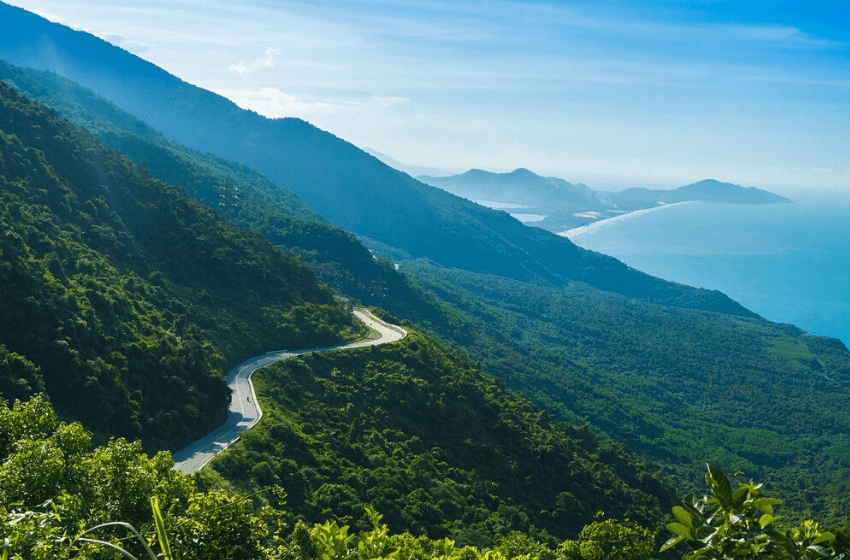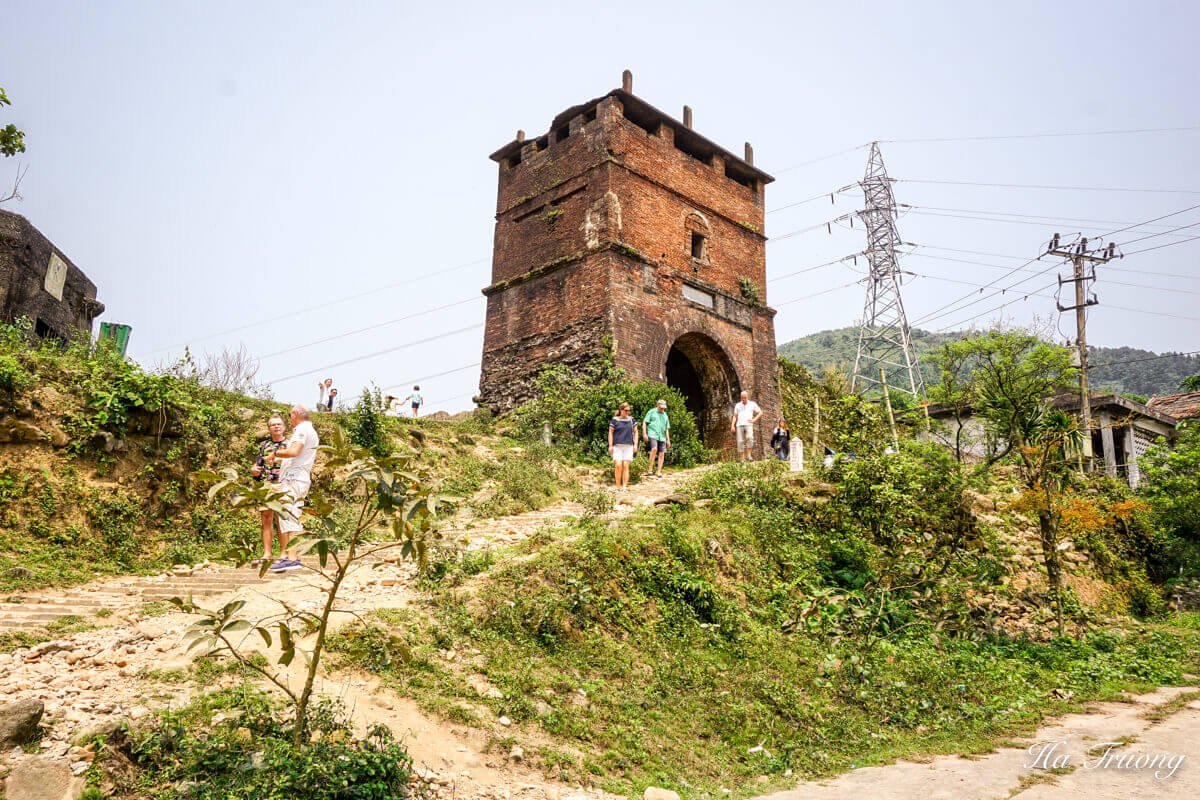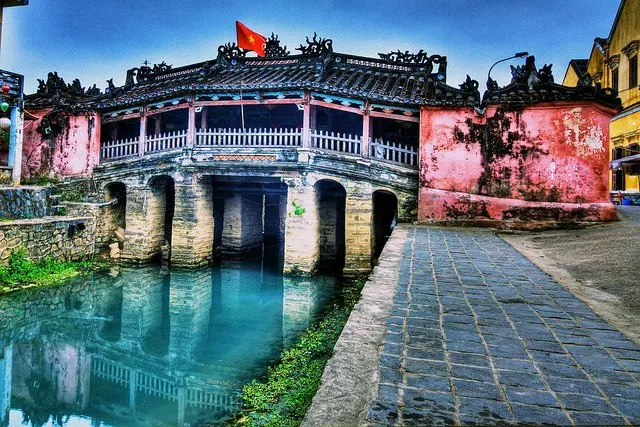Hai Van Pass is a mountain pass located in central Vietnam, between the cities of Da Nang and Hue. It is widely considered one of the most picturesque drives in Southeast Asia, known for its breathtaking views of the East Sea and the lush green mountains that surround it. The pass is 20 km long and winds along the coast, reaching an elevation of over 500 meters at its highest point.
The road through Hai Van Pass is a popular destination for tourists seeking a scenic driving experience. With its challenging curves, the drive is both thrilling and visually stunning, with views of the sea, mountains, and tropical forests along the way. The pass is also of historical significance, as it was once an important strategic point for military defense, and is surrounded by fortifications and fortresses that are still visible today.

In addition to its scenic beauty, Hai Van Pass is also a cultural hub, dotted with traditional villages, temples, and markets that showcase the local way of life. Whether you’re a seasoned driver seeking an adrenaline rush, or just looking to enjoy the breathtaking views of Vietnam, Hai Van Pass is a must-visit destination.
Table of Contents
The History Behind the Famous Hai Van Pass
Hai Van Pass has a rich history that dates back many centuries. The pass was an important strategic point for military defense, and served as a boundary between the kingdoms of northern and southern Vietnam. The area was ruled by various dynasties over the years, and was repeatedly fought over by rival factions.

During the Nguyen dynasty, the pass was fortified and a system of fortresses and garrisons was established along the route to defend against invaders. The fortifications were strategically positioned to take advantage of the natural terrain and the pass remained a crucial military stronghold for many years.
In later years, the Hai Van Pass became a major trading route, connecting the port city of Da Nang with the former imperial city of Hue. It was an important commercial hub and played a key role in the development of the region. However, due to the challenging terrain, the road through the pass was often treacherous and subject to landslides, making travel difficult.
In recent times, Hai Van Pass has gained popularity as a scenic drive and a tourist destination. The road was improved and modernized, making it easier and safer to travel, and the stunning views of the sea, mountains, and tropical forests along the way have made it one of the most popular scenic drives in Southeast Asia. Despite its modern conveniences, the pass still retains its rich cultural and historical heritage, making it a fascinating destination for visitors from all over the world.
Tips for Planning a Road Trip to the Hai Van Pass
Here are some tips to help you plan a road trip to Hai Van Pass:
- Check weather conditions: Hai Van Pass can be treacherous in bad weather, so it’s important to check the forecast before setting out. Avoid traveling during heavy rain or strong winds, as the road can be slippery and visibility can be poor.
- Rent a motorbike or Danang Private car With Driver: Renting a motorbike or car is the best way to experience the scenic drive through Hai Van Pass. Choose a reliable vehicle with good road handling and make sure it’s well maintained. Danang To Hue By Private Car Via Hai Van Pass

See More: Danang To Hai Van Pass Motorbike Tour
- Plan your route: The road through Hai Van Pass is 20 km long and takes approximately 45 minutes to drive, but allow plenty of time to stop and take in the views. There are several lookout points along the way where you can stop and enjoy the scenery.
- Take breaks: The drive through Hai Van Pass can be challenging, so it’s important to take regular breaks to stretch your legs and rest your eyes.
- Respect local customs: Hai Van Pass is surrounded by traditional villages and local communities, so be respectful and considerate when passing through. Observe local customs and avoid disturbing the peace.
- Wear appropriate clothing: Wear comfortable clothing and shoes suitable for a long drive, and bring a jacket or sweater for the cooler temperatures at the summit of the pass.
- Pack a picnic: There are several picnic areas along the way where you can stop and enjoy a meal with a view. Pack a picnic and enjoy a break from the road.
With these tips in mind, you’re sure to have an enjoyable and memorable road trip to Hai Van Pass.
Exploring the Spectacular Views of The Great Hai Van Mountains
The Great Hai Van Mountains, located along the coast in central Vietnam, are home to the famous Hai Van Pass and offer some of the most spectacular views in the country. The mountains are covered in lush green forests and dotted with traditional villages, temples, and markets that showcase the local way of life. Whether you’re exploring the area on foot, by bike, or by car, here are some ways to experience the breathtaking views of the Great Hai Van Mountains:
- Drive the Hai Van Pass: The most famous way to experience the views of the Great Hai Van Mountains is to drive the scenic Hai Van Pass. The road winds along the coast and offers stunning views of the sea, mountains, and tropical forests along the way.

- Hike to the summit: For the more adventurous, hiking to the summit of the Great Hai Van Mountains offers a unique perspective on the area and its breathtaking views. There are several trails that lead to the top, ranging from easy to challenging.
- Explore the local villages: The Great Hai Van Mountains are surrounded by traditional villages, many of which are still inhabited by local communities. Take a walk through the villages and experience the local way of life, visit temples and markets, and interact with the friendly locals.
No matter how you choose to explore the Great Hai Van Mountains, you’re sure to be struck by their beauty and natural wonders. So take the time to admire the views, breathe in the fresh mountain air, and enjoy the unique cultural heritage of this breathtaking region.
The Best Time to Visit The Hai Van Pass
Hai Van Pass and the Great Hai Van Mountains in Vietnam can be visited year-round, but the best time to visit depends on personal preference and the type of experience you’re looking for. Here’s a breakdown of the different seasons and what to expect during each:

- Summer (May to September): Summer is the peak tourist season in Vietnam and the weather is hot and humid. This is a good time to visit if you’re looking to enjoy the beaches and water activities along the coast.
- Monsoon (October to April): The monsoon season brings heavy rains to the region, but it’s also a good time to visit if you’re looking for a more authentic experience, as the area is less crowded and prices are lower. The rainy season also offers an opportunity to see the lush green scenery of the Great Hai Van Mountains.
- Spring (February and March): Spring is a great time to visit the Great Hai Van Mountains, as the weather is mild and the scenery is at its most colorful. The hills and forests are covered in a blanket of blooming flowers, making for a truly spectacular sight.
- Winter (December and January): Winter is the driest season in Vietnam and the weather is cooler, making it a good time to visit if you prefer milder temperatures. This is also a good time to visit if you’re interested in outdoor activities, such as hiking, as the trails are less slippery and the views are clearer.
Regardless of when you visit, the Hai Van Pass and the Great Hai Van Mountains are sure to offer an unforgettable experience, with breathtaking views and unique cultural heritage around every corner.
The Hai Van Pass is a true gem of Southeast Asia and offers a unique and unforgettable experience for travelers. So pack your bags, grab your keys, and set out on a journey to discover the beauty and cultural heritage of this breathtaking region. Whether you’re a seasoned traveler or a first-time visitor, the Hai Van Pass is sure to leave a lasting impression and provide memories that will last a lifetime.



[…] of the most popular destinations in Da Nang and Hue, near Lập An lagoon is Hai Van Pass. Poems and music may not be enough to describe the beauty of Hai Van Pass. After the winding roads […]
[…] of the exciting activities in Lang Co is admiring the coastal bay area from Hai Van Pass. Hai Van Pass has always been attractive to tourists due to its beautiful winding roads, and it becomes even more […]
[…] between Hue and Da Nang, Hai Van Pass is dubbed the “most majestic winding road in the world” by King Le Thanh Tong. With […]
[…] day trip from Da Nang to Hue will help you save time, and along the way, you can visit places like Hai Van Pass, Lap An Lagoon, Lang Co Beach, Hue Imperial City, Thien Mu Pagoda, Minh Mang Tomb, Khai Dinh […]
[…] addition, around the Nam O Reef area, you can also visit Van Village, Elephant Spring, and Hai Van Pass, all of which are extremely attractive […]
[…] experience. With a motorbike tour, you can combine visits to many famous tourist spots such as Hai Van Pass, Elephant Springs, and various Vietnamese countryside […]